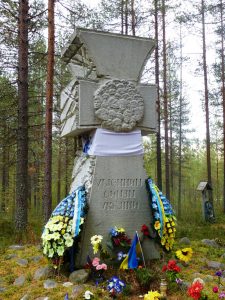On August 5, Ukrainians in Russia commemorated the victims of Stalinist repression executed in the Sandarmokh pine forest in the Republic of Karelia in northwestern Russia, reports Ukrinform, August 8.
Valeriy Semenko, an activist of the Ukrainian movement in Moscow, described the event:
“On August 5, we held a general meeting in the Sandarmokh forest. Afterwards the Ukrainian participants gathered near the memorial cross dedicated to the “slaughtered sons of Ukraine.” The Ukrainian delegation could be identified by flags and embroidered shirts. Many people came up and expressed their respect for Ukraine,” he said.
Members of the Ukrainian civic organization of the Republic of Karelia took part in the commemorative procession and the assembly near the memorial cross, along with Larysa Skrypnykova, honorary head of the Kalyna Ukrainian organization in Petrozavodsk, Oleksiy Kryvtsov, head of Perevesla organization in Voronezh, Valeriy Semenenko, representing Ukrainians of Moscow, and representatives of the Association of Victims of Political Repressions in Ukraine.
 Given the state of Russian-Ukrainian relations, this is the second year that no official delegation from Ukraine has taken part in the commemorative events in Sandarmokh. However, the Polish ambassador to Russia, Katarzyna Pełczyńska-Nałęcz, was present. She presented the Order of Merit of the Republic of Poland to Yuri Dmitriev, member of the Karelian Memorial Society who has made great efforts to perpetuate the memory of the Sandarmokh victims.
Given the state of Russian-Ukrainian relations, this is the second year that no official delegation from Ukraine has taken part in the commemorative events in Sandarmokh. However, the Polish ambassador to Russia, Katarzyna Pełczyńska-Nałęcz, was present. She presented the Order of Merit of the Republic of Poland to Yuri Dmitriev, member of the Karelian Memorial Society who has made great efforts to perpetuate the memory of the Sandarmokh victims.
The Ukrainian organization Kalyna in the Republic of Karelia has been honoring the memory of the victims of Stalinist repression for 18 years, On August 5, 2005, through the efforts of the Kalyna activists and the group’s head, Larysa Skrypnykova, a memorial cross was erected at the site of the mass executions.
Sandarmokh is a tract of pine forest in the Medvezhyegorsk region of the Republic of Karelia. Here on an area of some 10 hectares (25 acres), the NKVD in the 1930s executed more than 9500 people of 58 nationalities. Among the main victims were exiled settlers and prisoners from the White Sea-Baltic Canal (canal constructed by the forced labor of Gulag inmates, where some 25,000 workers died — Ed.) and the Solovetsky camps in the Soviet Gulag system, as well as residents of nearby villages. Over all, some 236 firing pits have been identified on this territory.
Among the executed were the pride and joy of the “Ukrainian Renaissance” of the early 20th century”: writers Valerian Pidmohylnyi, Mykola Zerov, Hryhoriy Epik, Mykola Kulish, Marko Voronyi, Valerian Polishchuk, the theater director Les Kurbas, historians Serhiy Hrushevskyi (brother of historian Mykhailo Hrushevskyi, president of the Central Rada of the Ukrainian National Republic), Oleksandr Badan-Yavorenko, Volodymyr Chekhivskyi, politicians, civic and religious figures, scientists, the military, and, in particular, a Vatican priest who was collecting data on human rights violations in the Soviet Union.
On May 28, 2015, the “Ukraine” TV channel opened a site titled “Resurrection of the Executed Renaissance,” dedicated to the writers and artists of 1920-30s who were executed, repressed and destroyed by the Soviet system.
Editorial Note: The Sandarmokh mass graves were discovered in 1997 by members of the Memorial Society, Russia’s best known human rights group, founded in 1989 under the auspices of Nobel Peace Prize laureate Andrei Sakharov. The organization has been active in exposing Soviet-era repression. The Kremlin is attempting to close down the group, labeling it a “foreign agent.”







